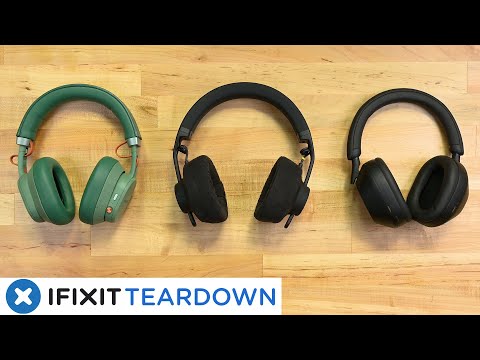
iFixit Teardown Review: Best Repairable Headphones!
It’s been a while since we looked at headphones and what better time to consider our options than with the release of Fairphones first ever over-ear headphones. We’re going to pit the Fairbuds XL against AIAIAI’s TMA-2 and Sony’s WH-1000XM5 to see how they stack up against each other. There’s a lot to consider, we’re looking for: Repairability Modularity Availability of spare parts And of course, sound quality and features. So without further ado, let’s teardown some headphones. The Fairbuds set the bar high, ticking all 4 of our boxes. It’s barely on the teardown table before I have the
battery out. Removing the power source is the very first step in any repair. The battery is rated for 800 mAh, and I couldn’t care less about the capacity because I can carry spares with me. Big win, loving it so far. A latch mechanism allows for easy replacement of the ear cushions. And check out the USB-C interconnect cable between driver assemblies. The very definition of an easily-replaceable component, this is an excellent design choice. The modularity train is on a roll, it only takes two Phillips screws to remove each earcup. I want to get to the headband
cushion and to do that I need to dismantle the arm mechanism. A tad more complicated than anything else so far but not an unreasonable ask. It’s a total of four screws per
isn’t offering replaceable PCB’s or ports, but in practice the modularity of the inner components should allow for easy replacement from a donor device. The squishy stuff around the port here isn’t the diehard adhesive often used to seal components in. It’s easy to cut through with a spudger and could easily be replaced with a flexible moisture proof seal. About the only part I struggled to figure out was the button. Don’t turn, just pull it out. Every other part is modular, from ports to the Active Noise Cancellation microphones. And since there’s no parts pairing, replacing any one
of these parts from a donor device is very doable. If I were to design one thing differently, it would be this board. Soldered connections are less accessible than ZIF or JST connectors. Moving on to the AIAIAI TMA-2 and, uh, this teardown’s already done for us. The box came with a modular headband, driver assemblies, and cables and ear cushions. Clearly we’re looking at the Ikea school of product design here. Alright, let’s take a look at the drivers. There’s not much in either ear cup. No battery, no wireless modules…so where’s all the processing happening? The Dyson Zone
hid some stuff in the headband so that’s where we go next. The headband is made of a rubberised material held in place by metal brackets on two sides. They’re easier to clean than faux leather and sturdier too. But it’s harder to remove than the ones on the Fairbuds, it has to be nudged away bit by bit. Removing it reveals double sided 3M tape which is definitely odd. Some screws, kapton tape, some more screws and voila: the battery is revealed on one side of the headband and the processing and communication modules on the other. An interesting
contrast to the Fairbuds where all the components were placed in the driver module. Again, I find myself wishing they’d avoided soldering any cables but, overall, not a bad design at all. The power source is a tiny 970 mAh single cell battery. Now check this out, this is the epitome of designing with repair in mind. The battery cable is routed across the headband so replacing it requires us to remove the 3M tape to access those cables. So what do you do after you’ve replaced your battery? It’s double sided tape, just flip it over and reuse it.
Absolutely love this. The last set of headphones on our list is a little more mainstream and definitely the most expensive. The Sony WH-1000XM5 offers modular earcushions and getting into the driver module is fairly straightforward when compared to other big brand headphones. They’re definitely not as repairable as our other headphones but it’s a worthy contender for its easily accessible battery. Using a JST-style connector and light adhesive makes a battery replacement a very light lift. The battery is the largest of the three headphones, rated at 1200 mAh. Beyond the earcushions and the battery, it does start to
get awfully complicated in a hurry. Bearing in mind that these are premium headphones with both audio and ANC that’s far superior to the competition, a little complexity can be forgiven. Still, I do wonder if some of this design could have been simplified. Separating the driver assembly from the headband requires removing several components and a bit of prying but it does eventually come away. Options for repair here are limited to scavenging parts from donor devices but it would be viable if not for the scarcity of available parts. Ranking our favorite headphones based on repairability, modularity, availability
of spare parts, and quality of features, I felt that both the TMA-2 and the Fairbuds held their own really well, especially where repair is concerned. The TMA-2 easily wins on modularity but I’d give the crown to the Fairbuds for an excellent balance between functionality and repairability. Unfortunately, they aren’t currently available for sale in the US. The Sony’s are a bit of an outlier but definitely outperforms the Fairbuds and TMA-2 in audio quality and features. However, where it falls short is repairability and spare parts, though it partly redeems itself with a fairly replaceable battery. If you’re
looking for a slightly higher end audio experience, then these are probably the ones for you. Let us know your pick for the most repairable headphones down in the comments.
